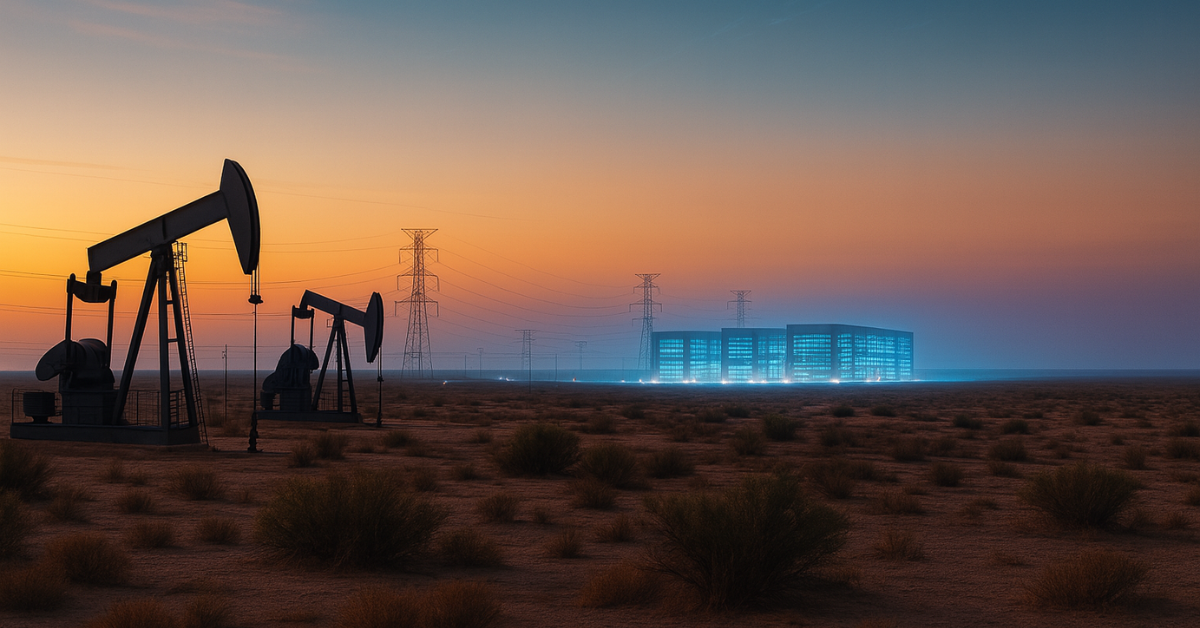The once unstoppable Texas shale boom is showing clear signs of fatigue, but a new surge of demand from artificial intelligence data centers may give the state’s oil and gas sector a much-needed second wind. While drilling activity and rig counts have slipped, the very technologies driving the next industrial revolution are fueling a new energy market that could reimagine the role of hydrocarbons in Texas’ future economy.
The Federal Reserve Bank of Dallas reported a second consecutive quarter of contraction in oil and gas production activity during the third quarter, marking a clear cooling trend. The national rig count, led by a slowdown in Texas, dropped in August to its lowest level in nearly four years, according to Baker Hughes data. Diamondback Energy CEO Kaes Van’t Hof put it bluntly in his August letter to shareholders: “At current oil prices, U.S. shale oil production has likely peaked and activity levels in the Lower 48 will remain depressed.” Industry sentiment echoes that pessimism. One Dallas Fed survey respondent said, “The U.S. shale business is broken,” blaming political hostility and economic pressure for gutting what was once the world’s most dynamic energy engine.
Yet, while upstream growth has plateaued, the rise of the AI-driven economy is opening new avenues for Texas operators. The Electric Reliability Council of Texas (ERCOT), which manages 90 percent of the state’s electricity load, now projects Texas power demand will soar from 148 gigawatts by 2030 to 208 gigawatts, an increase of 60 gigawatts in just five months of updated forecasts. Nearly 50 gigawatts of that load is expected to come directly from AI and cloud data centers, whose insatiable need for energy is reshaping Texas’ economic landscape.
AI’s Power Appetite Meets Texas Energy Assets
Data centers consume immense amounts of electricity and require reliable baseload power, which has thrust natural gas back into the spotlight. Analysts say the Permian Basin’s abundant energy assets, from turbines to stranded gas fields, are ideally suited to support this new industrial demand. “West Texas has vast open land suitable for both data centers and new power generation assets,” said Markus Mowatt-Larssen, an energy transition analyst at Welligence. He noted that operators can co-locate data centers with existing upstream infrastructure and use stranded gas that currently lacks pipeline access.
The synergies extend beyond power generation. Produced water from drilling operations, a waste byproduct long considered an environmental burden, can be repurposed for the massive cooling systems required by AI facilities. Likewise, gas that would have been flared into the sky can now be monetized by redirecting it to customers hungry for consistent power. The combination of excess gas supply, available land, and ready infrastructure makes Texas an ideal ecosystem for data-driven energy development.
The wave of new deals confirms that the market is moving fast. In late August, Vantage announced a $25 billion plan for a 1.4-gigawatt data center campus in West Texas. Around the same time, Skybox Datacenters began construction on a 300-megawatt facility near Dallas. In November, New Era Energy & Digital partnered with Sharon AI to build a new data center directly at New Era’s existing Permian Basin operations, an example of oilfield assets being converted into AI-ready energy hubs.
Perhaps the most ambitious effort yet is the proposed “Stargate” project, a collaboration between OpenAI and Oracle targeting an extraordinary 10 gigawatts of power capacity, with a potential investment reaching $500 billion. Gabriel Collins of Rice University’s Baker Institute said the Permian’s existing infrastructure gives developers a decisive advantage. “In a world where speed matters, the ability to rapidly build gas pipelines, power plants, and local transmission lines gives the Basin a unique edge,” he said.
Upstream Producers Adapt to the Digital Energy Economy
Even traditional operators like Diamondback Energy are now rethinking their business models. Despite its bearish view on oil prices, the Midland-based producer is pursuing opportunities in the power sector. On its fourth-quarter earnings call, Diamondback revealed plans for a joint venture to build a large “behind-the-meter” natural gas plant designed to supply electricity directly to data centers. The company plans to use a portion of the generated power for its own operations and sell the rest to hyperscale clients. “We’re still confidentially discussing it with the hyperscalers,” Van’t Hof said, referring to major cloud computing firms, “and getting feedback on how much gas we have that needs a better market.”
The strategy mirrors a growing national trend. Meta is developing a $10 billion data center in Louisiana that will partially rely on behind-the-meter natural gas generation, while a Pennsylvania developer is transforming a retired coal plant into a 4.5-gigawatt gas-fired data center hub. Yet Texas maintains a competitive edge with its open land, robust energy infrastructure, and business-friendly regulatory climate.
The scale of Texas’ coming transformation is hard to overstate. By 2030, the expected 50 gigawatts of power demand from data centers alone could supply nearly three times the electricity required to power every household in the state today. Mowatt-Larssen said persistent delays in grid interconnections, intermittent renewable output, and global supply chain disruptions have made dependable gas infrastructure indispensable. “Grid connection delays of five or more years and the intermittency of renewables have put natural gas infrastructure in high demand,” he said. “The result for upstream players is a profitable power business.”
While the shale boom that once defined Texas is cooling, the next great energy expansion may be digital. The oil and gas sector’s extensive footprint, its pipelines, turbines, and deep technical expertise, positions it to play a central role in meeting the AI economy’s massive appetite for power. For an industry searching for stability in uncertain times, the marriage between hydrocarbons and high tech could represent not just survival, but a new foundation for long-term growth.










